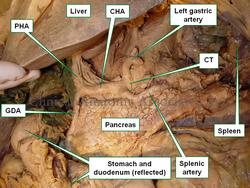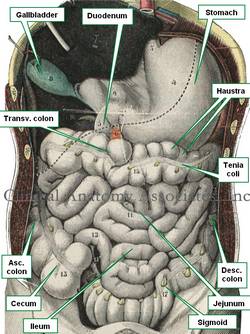|
The word [haustrum] is Latin and refers to a sac or scoop-like leather bucket used by the Romans to draw water out of a well. The plural form is [haustra].
In anatomy, the word [haustrum] is used to refer to a sacculation or outpouching of the colon caused by the constant tonus contraction of the longitudinal muscle fibers found in the tenia coli, as well as the distribution of circular fibers. See accompanying image. Click the image for a larger depiction.
Since the small intestine is not necessarily always small in relation to the colon (because of food content, intestinal gases, or pathology), the location of the organ and the presence of haustra, as well as the presence of tenia coli and appendices epiploica, is used to recognize the organ as colon.
The term can also be used as an adjective and the colon can be said to be "haustrated".
The word seems to have been used for the first time by Albrecht Von Haller (1708 - 1777) a Swiss anatomist, botanist, and physiologist.
Sources:
1. "Dorlands's Illustrated Medical Dictionary" 26th Ed. W.B. Saunders 1994
2. "The origin of Medical Terms" Skinner, AH, 1970
3. "Tratado de Anatomia Humana" Testut et Latarjet 8 Ed. 1931 Salvat Editores, Spain
Image modified from the original from Testut and Latajet, 1931
|
Image modified from the original from Testut and Latajet, 1931
|





